Black bees are both common and mysterious. Native to many parts of the United States, black bees can have different color combinations.
Mostly black bees can have a uniform black color or a dark color with blue, green, red, or yellow undertones.
Some black bees have yellow or white body parts as well.
Table of Contents
Are Black Bees Dangerous?
Most black bees found in North America aren’t dangerous. They even live in remote locations such as chaparral habitats where they might not be stumbled upon easily.
Many types of black bees also live solitary lives. They might not live in hives which means they aren’t as easy to spot.
While common, black bees are still not deeply studied.
The Spring Beauty Miner is one example of black bee species that’s very common but that hasn’t been in the spotlight of bee research compared to other colored bees.
While not particularly aggressive, black bees might still sting when threatened or roughly handled.
Types of Black Bees
1. Southern Carpenter Bee
Southern Carpenter bees (Xylocopa micans) are common in the Southern US as well as in Mexico.
These bees have an all-black color. This color has certain nuances or undertones when the Sun shines directly on the bee.
These undertones are blue or green.
Like carpenter bees, the species nests in wood. It prefers woody plants which means the Southern Carpenter bee doesn’t nest in the wood that makes homes.
These bees have also been shown to have different mating strategies. One of them involves the territorial hold of males which takes control over an area with blooming flowers to attract more females.
2. Carpenter-mimic Leafcutter Bee

Common in the South as the Southern Carpenter bee, the Carpenter-mimic Leafcutter bee (Megachile xylocopoides) has a similar all-black body without any colored undertones.
This short and wide bee can measure up to 13mm in the case of females. But many measures around 10mm.
These bees get their name from their capacity to carry and utilize plant leaves to line their nests.
A single female bee can carry a small green leaf further used as a wall inside its nest.
The skill these bees have with leaves is considered superior to other bees which may only pierce leaves.
These leafcutter bees can segment leaves but they can also roll them into a tunnel or a cigarette shape in a matter of minutes.
3. Two-spotted Longhorn Bee

Two-spotted Longhorn bees (Melissodes bimaculatus) are some of the most common black bees little is known about.
Bees of this genus have a black body with yellow hairs on the rear legs that look similar to pollen.
Crops and farmland are among the favorites for these bees as they visit corn, squash, wild bergamot, and asters first.
These bees are believed to only nest in the ground in certain areas.
Common in the US, Two-spotted Longhorn bees are very commonly confused with Carpenter-mimic Leafcutter bees.
However, these bees have yellow hairs on their legs and not on the abdomen.
4. Western Carpenter

The Western carpenter (Xylocopa californica) is a type of bee that’s almost completely black. This species has golden hairs on the pronotum.
The almost all-black bee is common in the warmest US states where it remains very active during the summer and is an important pollinator.
Western carpenters are found on both coasts in Florida and California.
The bees are found next to chaparral woodlands.
This species visits multiple flowers where it stands out with its black body. It prefers flowers native to Western North America.
5. Hawthorn Mining Bee
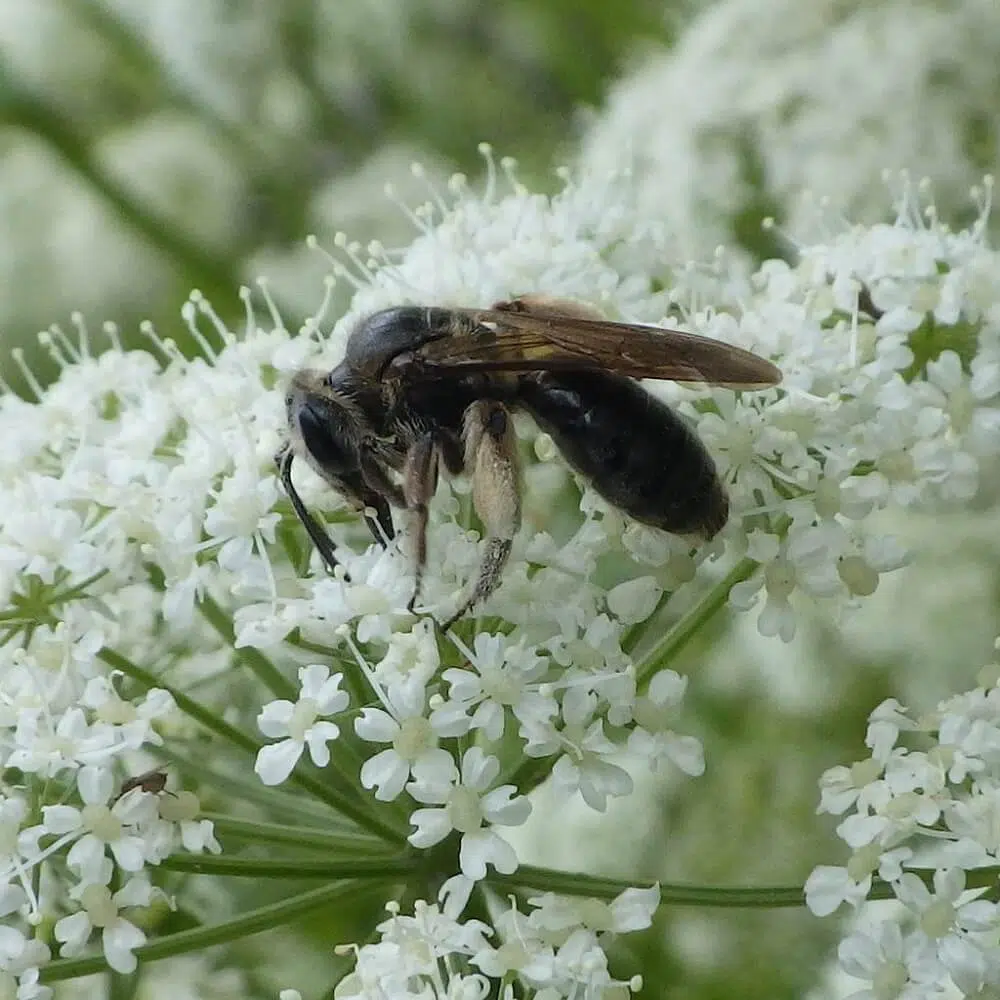
These all-black bees (Andrena crataegi) are identified by the position of their wings which sit at 45 degrees.
These are one of the most come types of black bees seen in Northern US states.
Many black bees are found in Southern states but the Hawthorn Mining bee lives in temperate climates in North America and Europe.
6. Spring Beauty Miner

Spring Beauty Miner bees (Andrena erigeniae) have a black body with white or yellow hairs.
These bees have dark brown wings and are common around woodlands or on the edge of woodlands in the summer.
Bees of the Spring Beauty Miner visit multiple flowers per minute, essentially collecting pollen on their body.
These bees grow to 8mm and are mainly known for visiting purple flowers such as Virginian spring beauty.
Many also see these bees collecting pollen from other similarly-colored flowers such as lavender.
7. Nimble Ceratina

The black color with metallic undertones is characteristic of this bee species (Ceratina strenua).
There’s little coloring difference between males and females of the species. Females only have a lighter femur compared to males.
The species is common in the Eastern parts of the US, including New York.
Bees of the genus grow to 6mm in the case of females and up to 5mm in the case of males.
These bees are part of the Ceratina group. This is also a group known as a small category of carpenter bees.
Nimble Ceratinas nest in dead wood, logs, and branches. They don’t nest or damage structural wood.
8. Dieunomia heteropoda
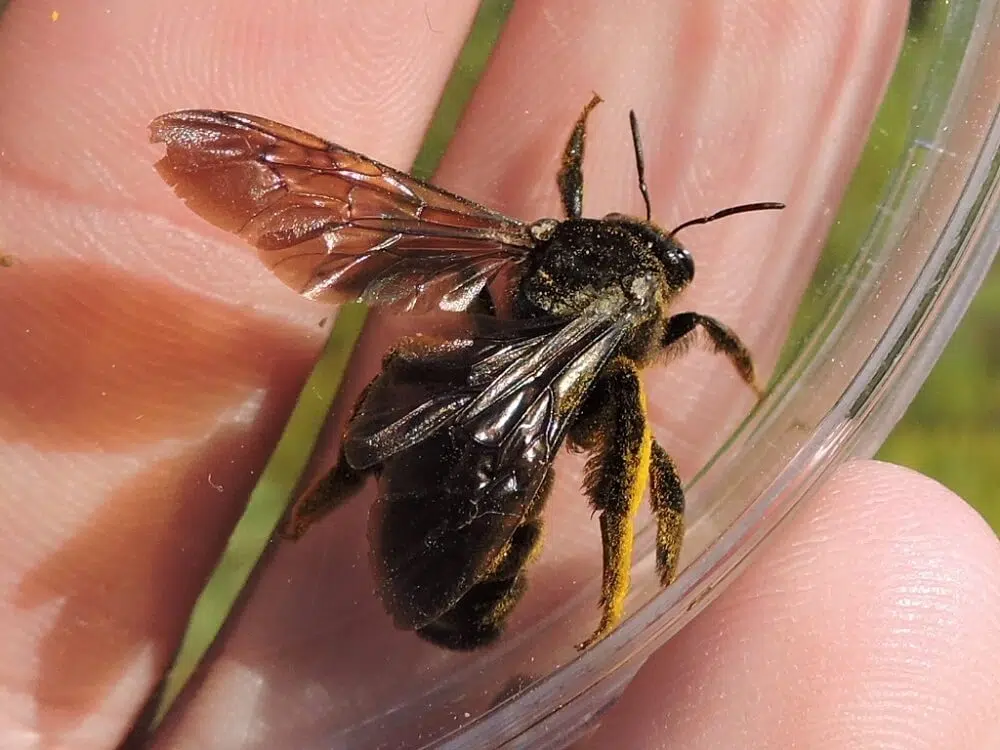
This species is common across the US and in Southern Canada.
It has a black and brown body. The bee has a mostly black body with brown bands.
This species has a black body and brown wings.
Some brown marks and stripes can be seen in certain areas on Dieunomia heteropoda.
It collects pollen with hairs across its body, particularly on its lower abdomen.
9. Osmia chalybea
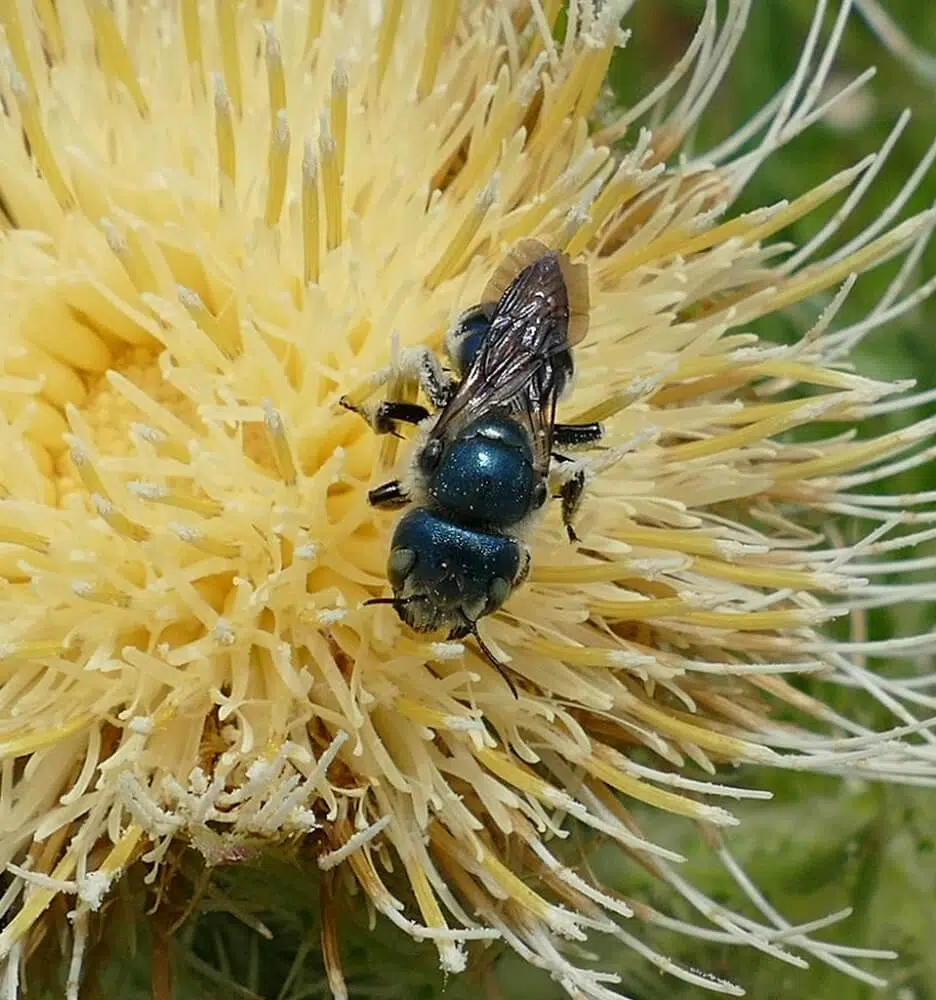
These bees have a black color with blue undertones.
It can be found in Southeastern territories from Texas to Florida and on the Eastern Coast up to Canada.
These bees like to visit wildflowers but most people know them for using mud to build small nests.
Bees of this genus use mud and water to form small nests for their eggs. These mud nests are created almost anywhere such as on trees and even on homes.
Bees of this genus use existing cracks or crevices for their nests which they close off with mud.
10. Pacific Digger Bee
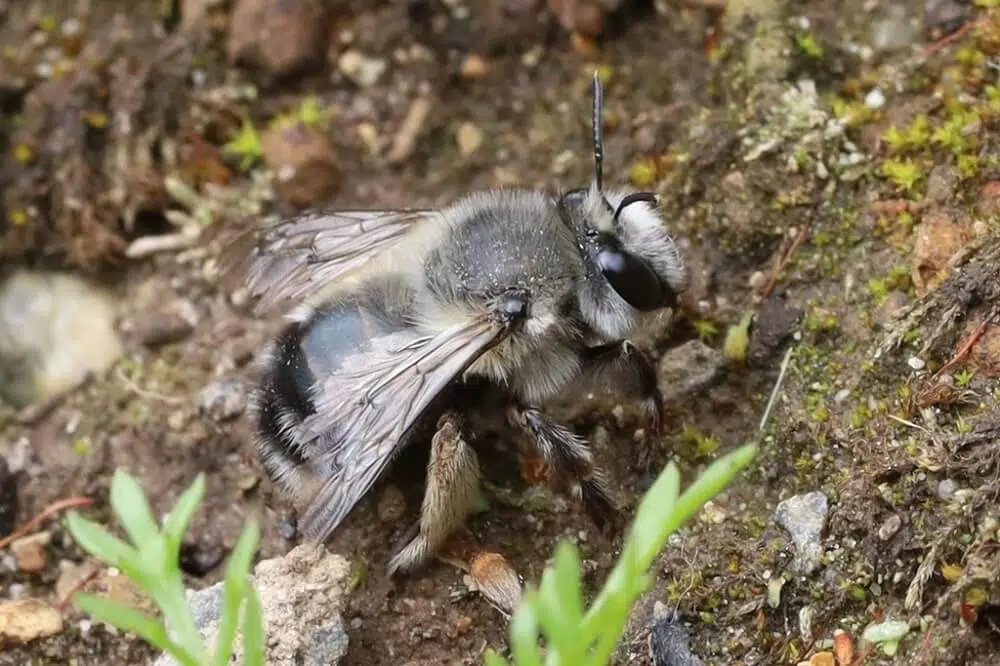
Native to North America, the Pacific Digger bee (Anthophora pacifica) is a species that nests in the ground.
It prefers loose soil to dig small individual nests.
Bees of this genus are further known for their black body with white hairs. Their wings are also black.
Native to Western North America, the Pacific Digger bee also comes in yellow marks with yellow mouthparts in the case of males.
Some color variations have further been spotted in the species.
Bees found further North might exhibit horizontal stripes on the abdomen of a golden-yellow color as opposed to the almost all-black bees in the South.
11. Bristle Sweat Bee

The Bristle Sweat Bee (Lasioglossum imitatum) is a common black bee. It grows to a size of 4-6mm and females are known to be larger than males in the species.
Bristle Sweat bees aren’t completely black. They have golden yellow undertones which are most visible when the Sun is shining directly on them.
These bees collect pollen and don’t bite as many mistakenly assume.
Bristle Sweat bees only follow people due to their sweat pheromones.
Bees of this genus can be spotted in almost all states in Eastern parts of the US.
12. Cherry Plum Mining Bee
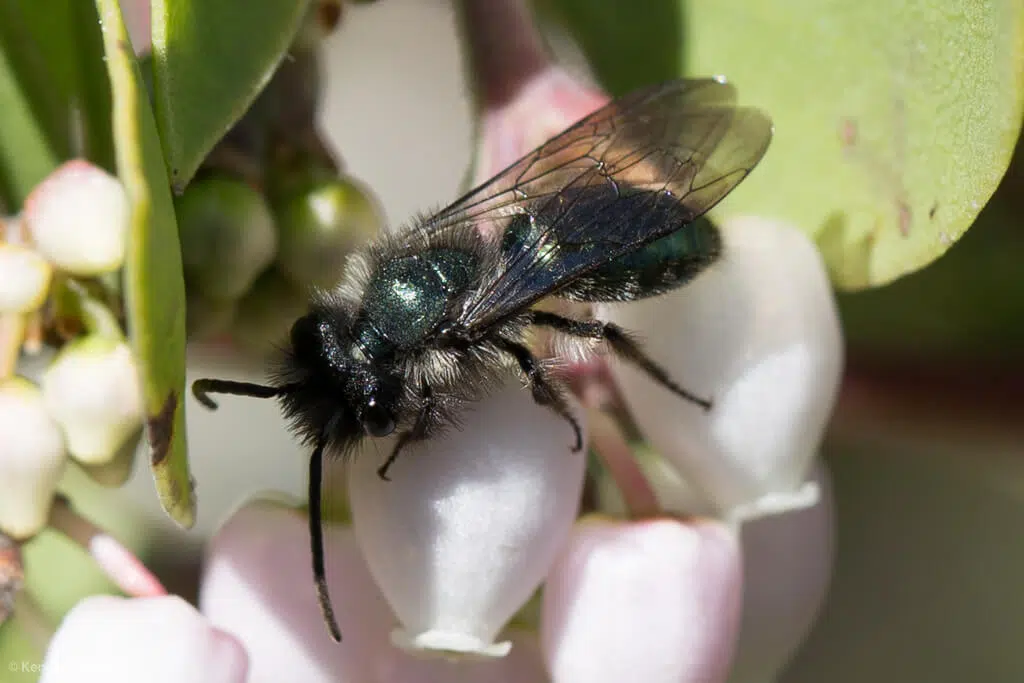
Cherry Plum Mining bees (Andrena cerasifolii) have a black body with a strong metallic green influence.
Bees of the genus have black wings and black hairy legs.
Cherry Plum Mining bees don’t eat actual cherries. They are only seen in the spring when cherry blossom provides a great source of pollen.
These types of mining bees aren’t exclusively feeding on cherry blossom pollen. They also visit plum and peach trees.
Bees of this genus are mostly found around fruit trees and they are known to dig in loose soil next to these trees.
13. Georgia Mason Bee

These bees (Osmia georgica) have a black body with a turquoise undertone.
Bees of this genus appear yellow or orange, especially on the abdomen when they finish collecting pollen.
These bees are slightly larger than other more common black bees as females grow to 9mm while males grow up to 6.5mm.
The Georgia Mason bee is a solitary species. It’s never seen in groups except during mating periods.
Georgia Mason bees are highly common in grasslands and in areas of dense vegetation where there are many types of wildflowers.
Daisies are among the favorite flowers of Georgia Mason bees which might be a common sight on daisy fields.
These bees remain active in the warm season, mainly until early fall.
14. Frigid Mining Bee
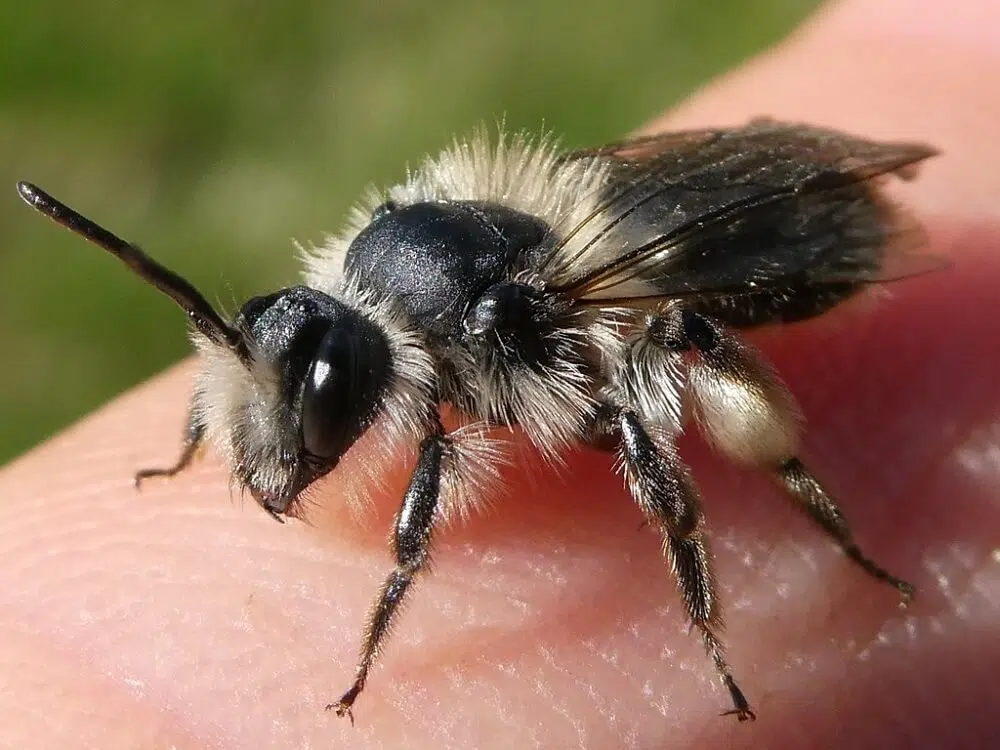
The Frigid Mining bee (Andrena frigida) is a black species identified by its white or silver hairs on the terga.
The species has moderately-long antennae which are black and legs that are red-brown or black.
Frigid Mining bees are cosmopolitan. These bees can be found everywhere in North America from vast territories in Canada up to Alaska and in most US states.
Frigid Mining bees are good pollinators and can be seen very early in the season.
Male bees are seen in March. Females are more common and easier to spot since they’re also larger.
Female Frigid Mining bees grow to a size of up to 11mm.
15. Brown-fovea Miner
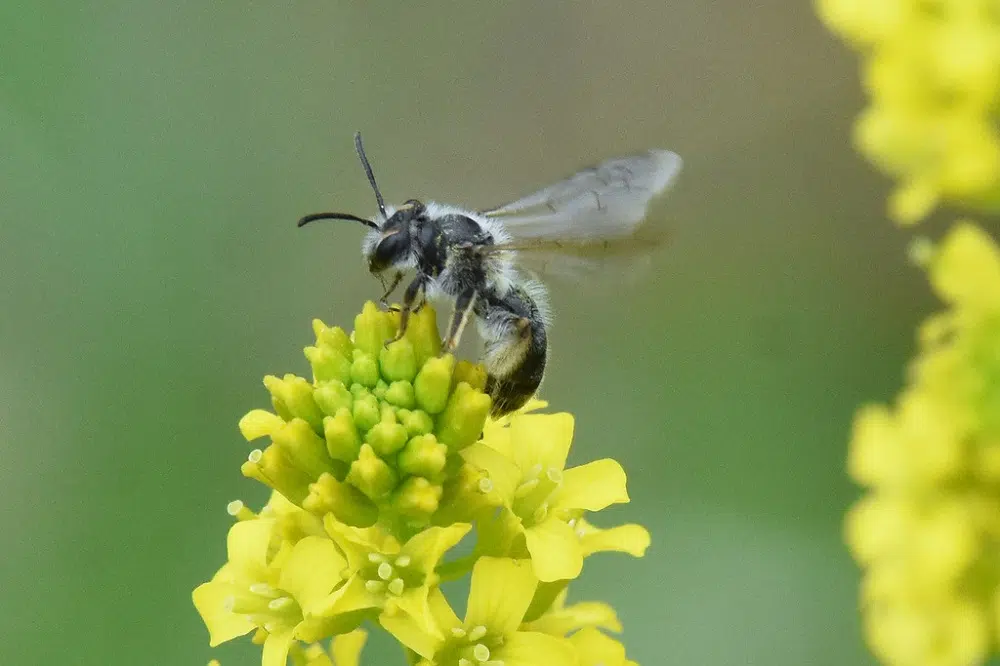
Brown-fovea Miner bees (Andrena rufosignata) get their name from the red-brown hairs on their body, except the abdomen.
These black bees have distinct colored hairs, black wings, black legs, and black antennae.
They are extremely tolerant to cold weather and present in high numbers even in cold states.
Bees of this genus might even emerge before the last frost. This is March when these bees can emerge and mate.
They nest in the ground by digging vertical individual tunnels, preferably in loose or sandy oil.
Bees of this genus are known to collect pollen from multiple flowers, even if they have their preferences.
Pollen is then laid in nests where developing larvae can feed during the winter.
16. Beebalm Shortface
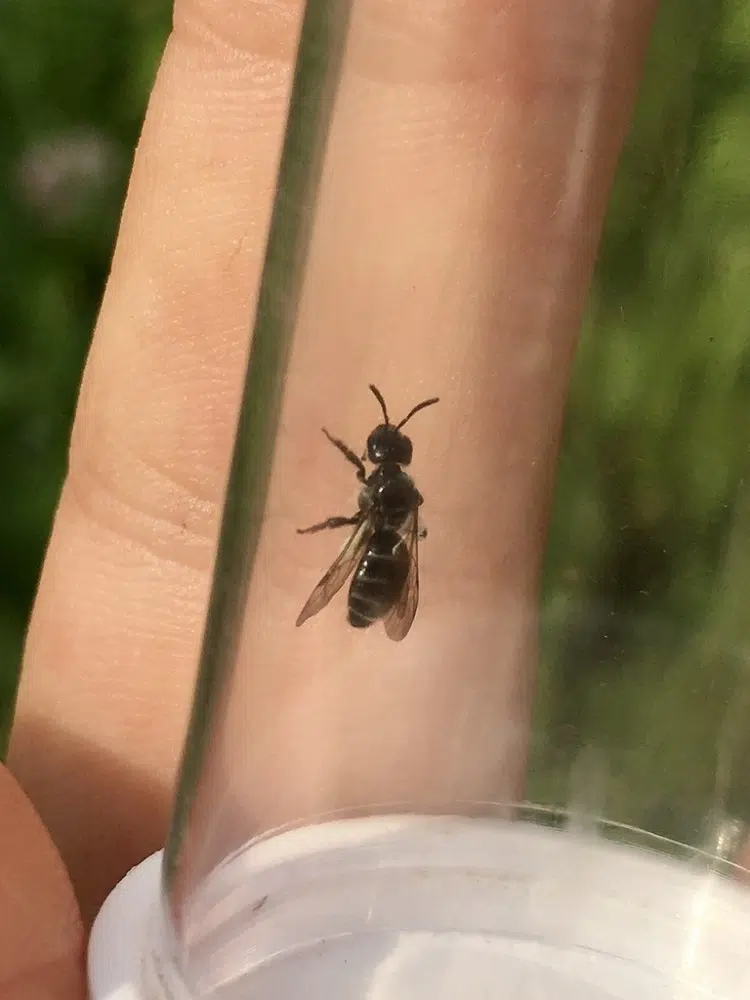
Beebalm Shortface bees (Dufourea monardae) have an all-black body.
They have a shiny nuance and no other distinctive traits apart from short white hairs on their body.
Bees of this genus are not general pollinators as they do not visit a wide range of flowers. Beebalm Shortface bees only visit wild bergamot or beebalm.
This native plant is known for being the main source of oil of thyme.
Bees of this genus are found everywhere this flower is found.
Growing in shrubs of up to 3 feet, these flowers provide fragrant pollen that attracts Beebalm Shortface bees and other species of bees.
17. Violet Carpenter Bee

The Violet Carpenter bee (Xylocopa violacea) is the largest bee in Europe and a distinct black species with violet undertones.
A common sight in many habitats, this bee was thought to have disappeared completely from certain habitats.
However, its large size makes it hard to miss whenever it appears in April.
Bees of this genus grow to a size of more than 1 inch, being a large species compared to other black bees.
Violet Carpenter bees have also been shown to sting. However, sting cases are rare since Violet Carpenter bees nest away from populated areas in decaying softwood.
18. Blue Orchard Bee
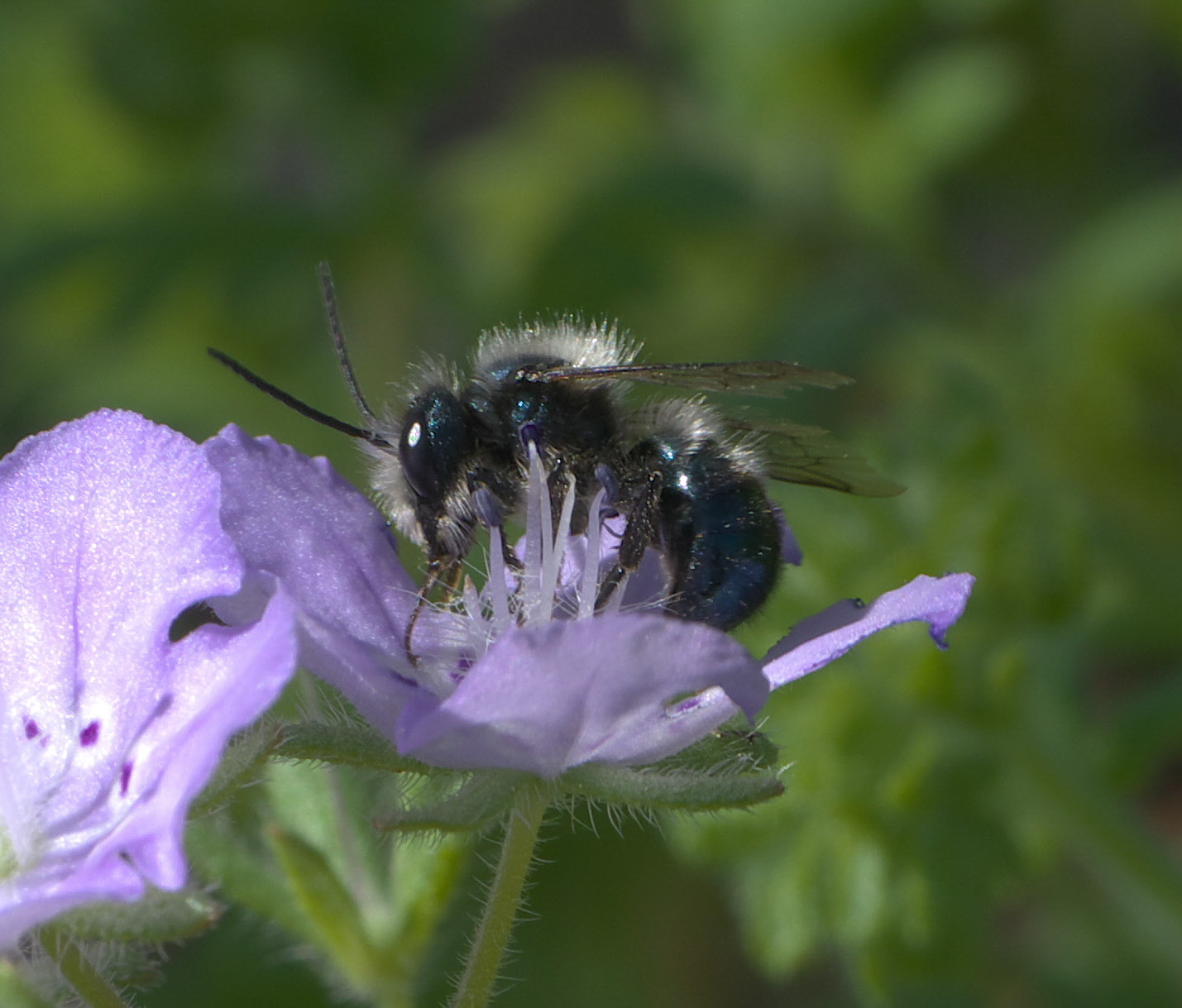
Blue Orchard bees (Osmia lignaria) are some of the most docile black bees in North America.
These bees do not sting. They might only do so in extreme situations, but their short stinger used to guide eggs is rarely used against people.
Blue Orchard bees have a black color with green and metallic undertones. The species build mud nests for its eggs.
It begins by finding a crevice or an existing cavity to build the back wall of the mud nest.
It then builds the entire mud nest to lay the egg and pollen in.
These bees also nest well in manmade bee nests. They cannot dig wood such as carpenter bees which means they need to utilize the space they find for building nests.
19. Paulista Bumble Bee

Paulista Bumble Bees (Bombus pauloensis) are native to South America.
These short robust bees have a hairy body and all-black coloring.
Paulista Bumble Bees live social lives under the guidance of one or multiple queens.
Colonies led by multiple queens often tend to break off as queens get in conflict with each other frequently.
These bees build nests either just above the ground or in trees.
This is where they live and where they store honey, but only in small quantities.
Bees of this genus can adapt to temperature changes through a process known as thermoregulation.
20. Spiny-legged Stingless Bee

Native to Brazil, the Spiny-legged Stingless bee (Trigona spinipes) is one of the most common species of black bees with a damaging effect on fruits.
This bee is known for collecting fruit and plant fiber for its nest so it can damage the flowers or fruit trees that are pollinated.
It damages flowers, blooms, and leaves of various trees. Passion fruit is one of the damaged fruits of this species.
These black bees use atypical nesting materials which include dung.
As a result, their less than sanitary habits make their honey unfit for human consumption,
Spiny-legged Stingless bees can consume their honey without repercussion.
21. Broad-handed Carpenter Bee

Broad-handed Carpenter bees (Xylocopa latipes) are common in Southern Asia.
These black bees have blue or green undertones and they are among the first black described bees in history.
Broad-handed Carpenter bees have a positive commercial pollination role. They are used by passion fruit cultivars for their beneficial pollination contribution.
Some studies suggest passion fruit blooming is in direct synchronization with the season of these bees/
These bees nest in wood and live solitary lives. These bees might also nest in structural wood creating damage to homes in Malaysia.
22. Splay-footed Carpenter

Splay-footed Carpenter bees (Xylocopa valga) are common in Europe and across the world. This species has a black body with blue undertones.
Completely black, the bee stands out in some of the bright colors it prefers to visit such as iris.
Bees of this genus are also larger than many other black bees. The female Splay-footed Carpenter can grow to a size of up to 27mm.
Splay-footed Carpenter bees nest in wood. They nest in old trees, logs, or other types of softwood they can easily tunnel through.
These bees live solitary lives and cannot congregate in colonies in a large nest.
23. Ridge-crowned Carpenter
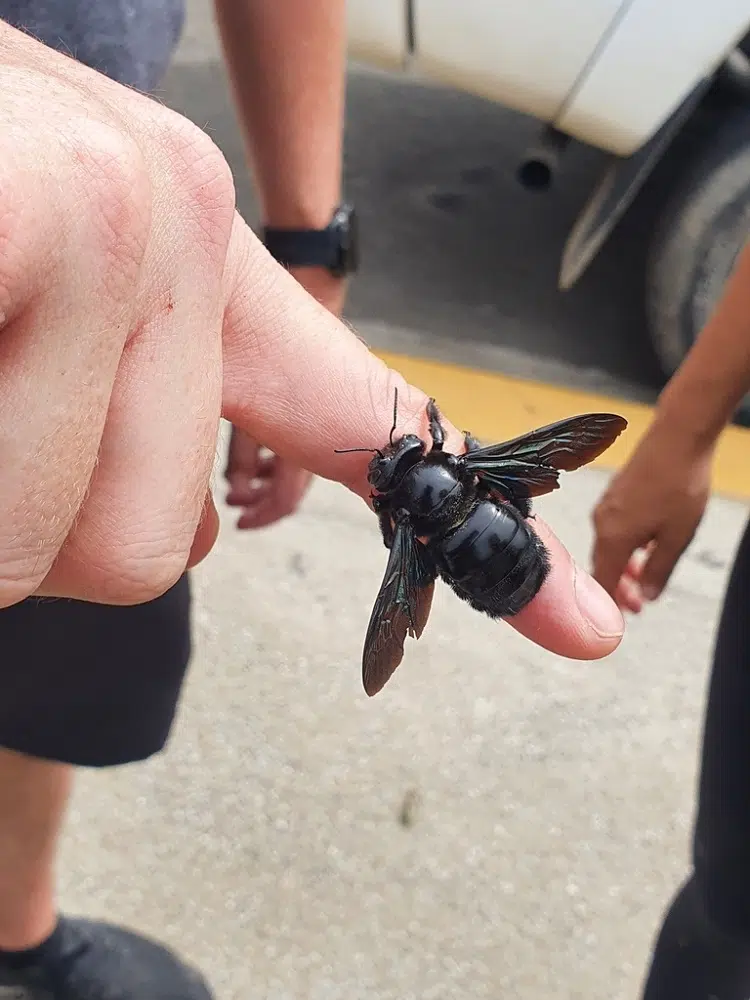
Native to Southern and Central America, the Ridge-crowned Carpenter bee (Xylocopa fimbriata) is found in countries such as Brazil and Mexico.
This bee species has a completely black body with black and brown wings.
Its role in nature is considered positive as it pollinates passion fruit.
Ridge-crowned Carpenter bees are commercially used for passion fruit pollination in South America.
Like other black bees that pollinate passion fruit, these bees also nest in wood.
24. Spurred Ceratina

Spurred Ceratina (Ceratina calcarata) is dark to black bees with a metallic undertone common in the US.
These bees are known pollinators of cucumbers and are commonly seen on various types of crops.
Living in clusters, these bees have very high reproduction rates through the lack of known parasites.
There are not many parasites for these bees to worry about as pesticide application on crops kills them.
These bees live in small clusters where they take care of their brood. Maternal care is specific to Spurred Ceratina.
25. Slender-scaped Carpenter Bee
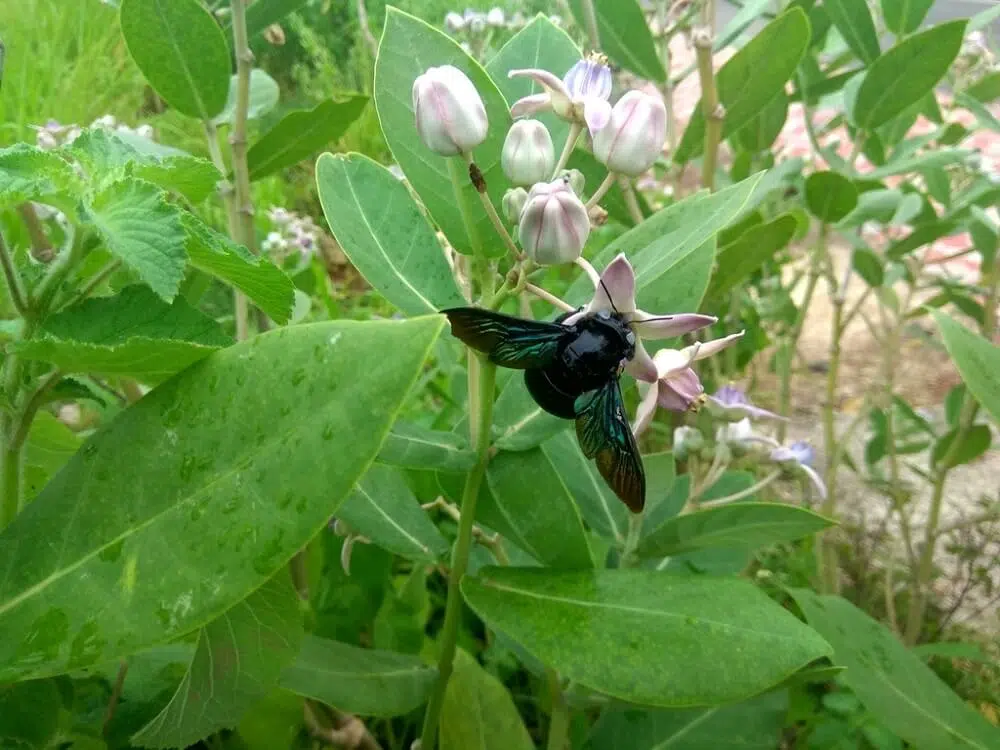
Slender-scaped Carpenter bees (Xylocopa tenuiscapa) have a dark body and metallic blue wings.
These bees are known for their robust allure and for being native to Southeast Asia.
Seeing Slender-scaped Carpenter bees isn’t easy since the species is nocturnal.
Many nocturnal carpenter bees such as the Slender-scaped Carpenter bees developed foraging techniques only possible at night.
For example, this bee species have adapted to only visiting trees that flower at night.
However, Slender-scaped Carpenter bees can sometimes be seen collecting pollen during the day at the beginning of their flight season.
26. Bronze-winged Bamboo-Carpenter

The Bronze-winged Bamboo Carpenter bee (Xylocopa tranquebarorum) is known for its resemblance to flies when it comes to the shape and of its body.
These bees have wings in bronze and pink colors.
As their name implies, the bees nest in bamboo. They only nest in dead bamboo.
Common in Asian bamboo forests, these bees are a common sight in China, India, and Japan.
Known pollinators, Bronze-winged Bamboo Carpenter bees visit flowers of multiple families, the main species around bamboo forests.
27. Arizona Small Carpenter
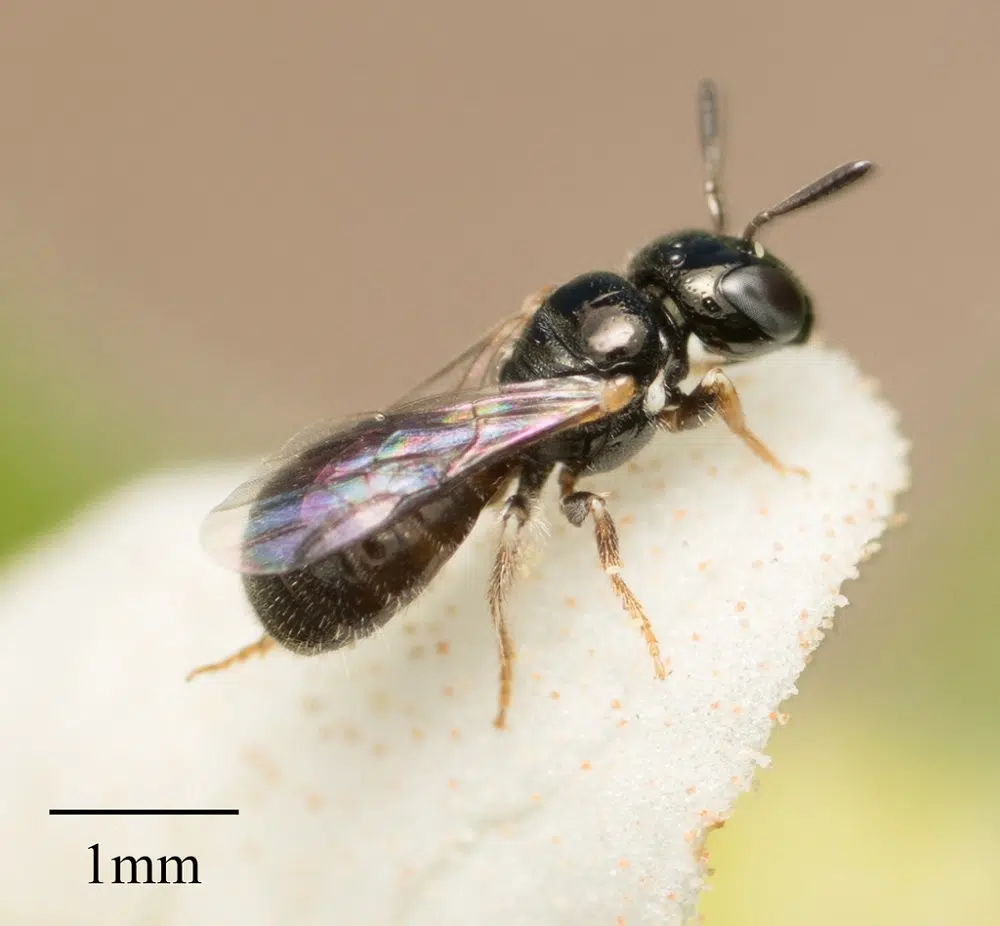
Common in California, Arizona, and New Mexico, the Arizona Small Carpenter (Ceratina arizonensis) has a shiny black body and bronze-brown wings.
Bees of this genus also occur in high numbers in Central America.
Regardless of its exact habitat, the Arizona Small Carpenter bee is mostly interested in flowers such as cat’s eye and popcorn flowers.
Bees of this genus are solitary and prefer to nest in dead wood.
28. Black Slender-Stingless Bee
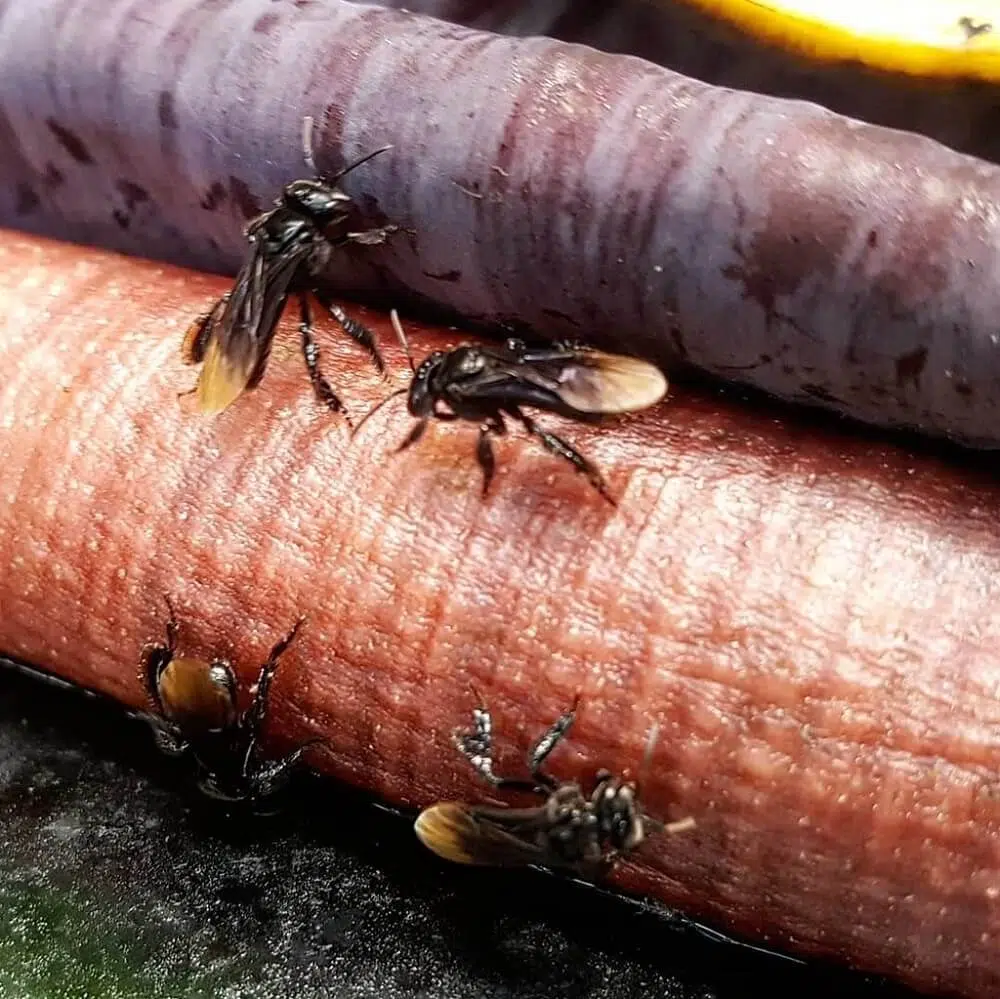
Black Slender-stingless bees (Frieseomelitta nigra) have an almost completely black body.
They have a black cephalothorax, black antennae, black wings, and black legs. The abdomen is almost completely black as well.
White is the color of the tip of the abdomen in Black Slender-stingless bees which makes for easy identification.
These bees aren’t solitary as they’re always seen in clusters.
Black Slender Stingless Bees are diurnal and visit multiple species of flowers during the day.
29. Common Masked Bee
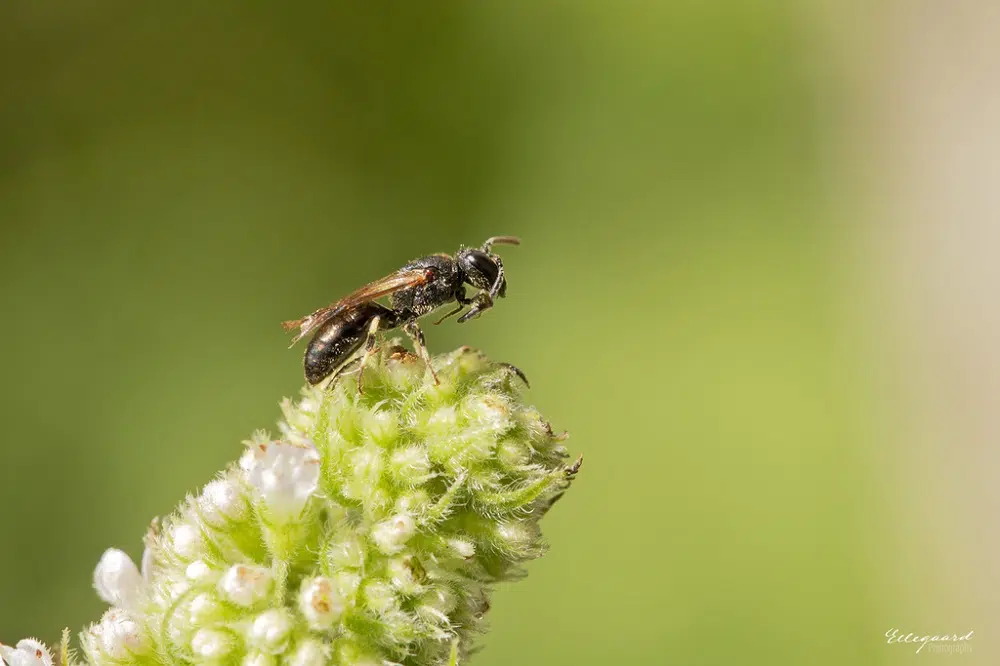
Common Masked bees (Hylaeus communis) forage on hedgerow cranesbill. These bees are common in Europe and they can be identified by their black bodies.
The main differences between these bees in their genders are the colored marked spots on the face.
Female Common Masked bees have 2 lateral yellow lines along the face.
These bees cannot excavate materials so they cannot nest in wood. They make the most of the cracks and crevices they find to hide in.
30. Black Mud Bee

The Black Mud bee (Megachile parietina) is a solitary species of black color with violet-blue metallic undertones.
Bees of this species have a shiny body with golden bronze wings.
Known as a solitary bee, the Black Mud bee builds small nests attached to buildings or trees.
These nests are made out of mud which these bees make from soil and water.
31. Yellow-collared Masked Bee

The Yellow-collared Masked bee (Hylaeus euxanthus) has a dark brown to black color.
These dark bees have yellow legs and yellow lines around their heads which make them look like wearing a masks.
Native to Australia, this species combines bright with light colors in a unique look.
Females of the species have a yellow-green head coloring alongside yellow lines on the cephalothorax.
32. Greater Antillean Carpenter
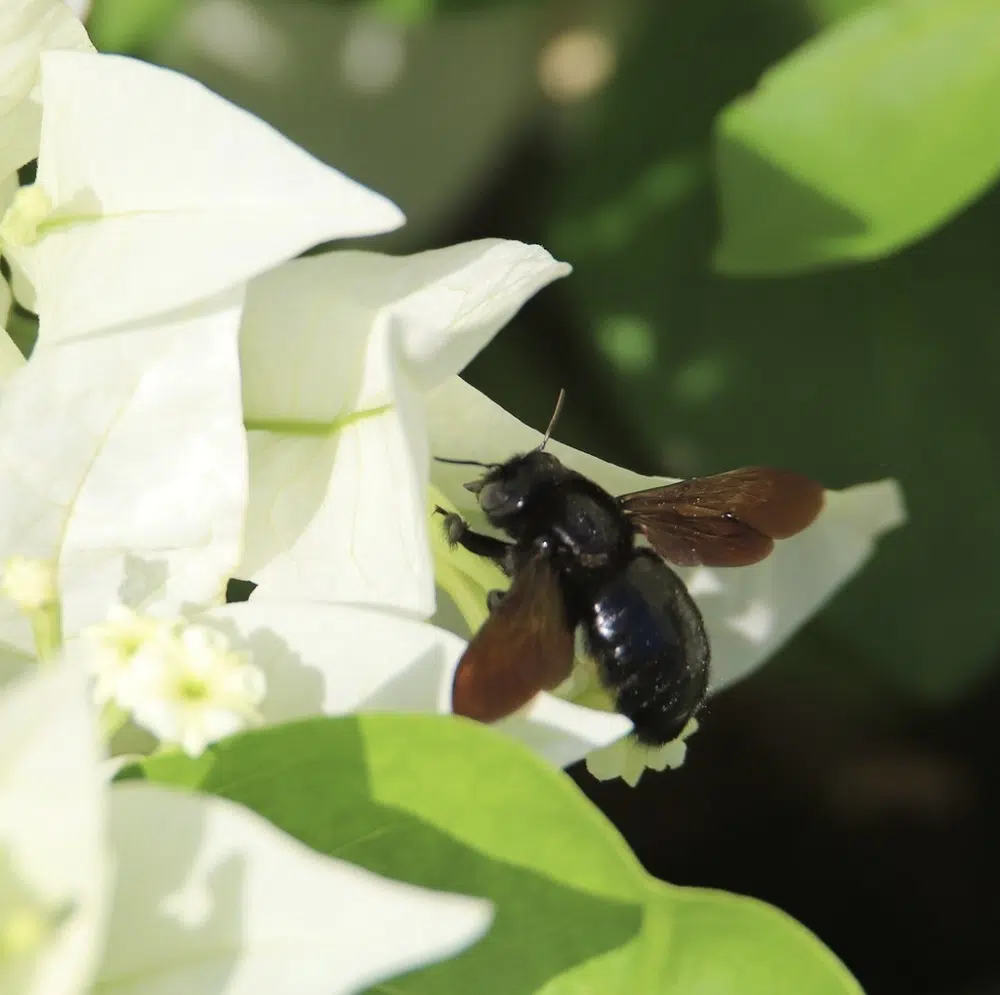
Native to South America, this carpenter bee (Xylocopa mordax) grows to a size of almost 1 inch. It has a distinct shiny black body with black wings.
Males of the species have a completely different look. They have a dominating orange-brown color with yellow stripes and dark wings.
This solitary species is diurnal and it can be seen visiting multiple species of flowers.
Greater Antillean Carpenter bees nest in dead wood.
They prefer to find cavities or small holes that already exist in wood to nest in.
These bees can also nest in structural wood. They are attracted to natural light and can make it indoors at night.
33. Windowed Carpenter
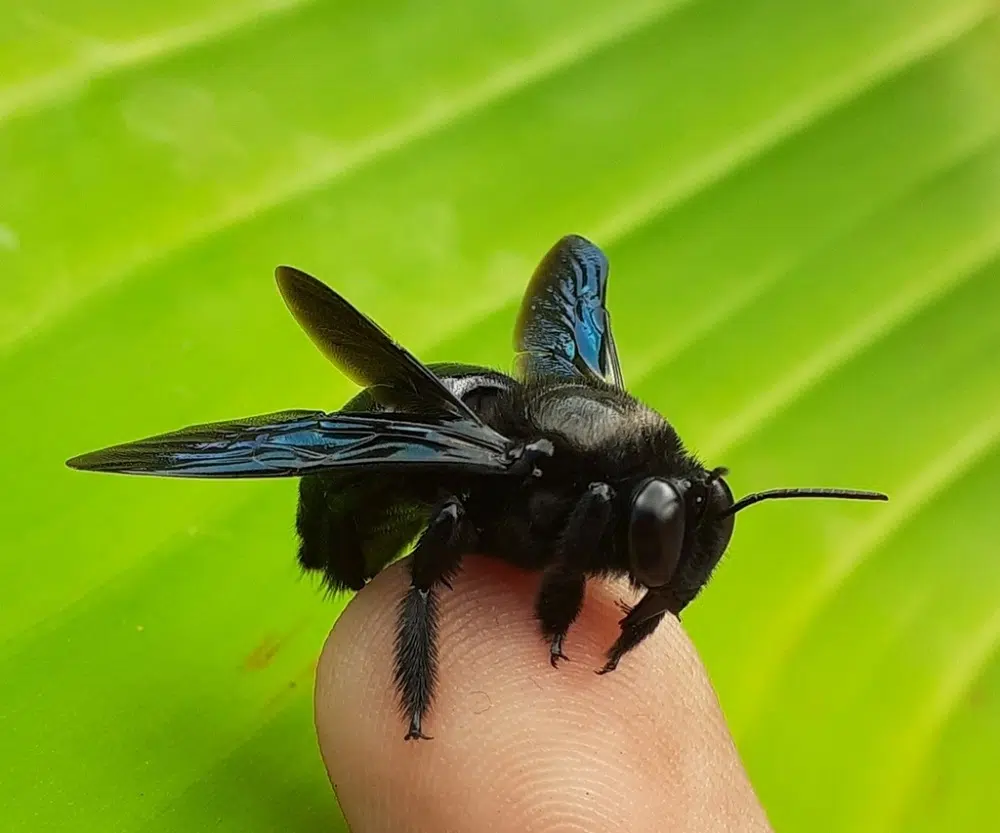
Windowed Carpenter bees (Xylocopa fenestrata) are black bees native to Asia and parts of Africa.
These black bees consume the pollen of various flowers and they generally live solitary lives.
In some cases, female Windowed Carpenters nest together. Females of the same generation or different generations can share a nest.
Windowed Carpenter is seen as beneficial pollinators. They pollinate various flowers around bamboo woodlands.
However, these bees also nest in bamboo. They prefer dead bamboo which means their potential for damage is reduced.
Windowed Carpenters can also burrow in trees or other plants in the absence of dead bamboo.
These bees have complex mating systems. Males can patrol an area looking for a prospective female mate.
Male bees can also hover in a given area as a way for prospective mates to pass by.
34. Violet-winged Mining Bee
Native to Europe, Violet-winged Mining bees (Andrena agilissima) are mostly black.
Males have a black body with white stripes while females are almost completely black with some yellow coloring on the legs.
Bees of the genus first appear in the spring. It’s the males that emerge first, mainly eating through the pollen deposited in their underground nests.
Males are ready to mate as soon as they emerge and they move along the nest of females waiting for them to emerge and mate.
Nests with multiple females are believed to be larger. Violet-winged Mining bees have large female nests also because the females of the species aren’t aggressive.
Violet-winged Mining bees always forage nearby their nests. They are seen early in the morning on various crucifers and other herbaceous plants.